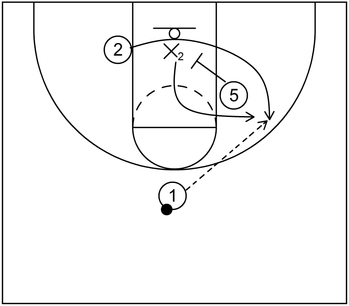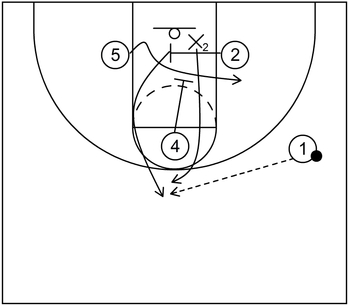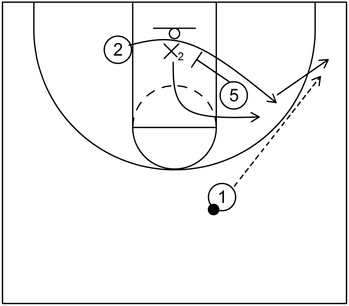What does shoot the gap mean in basketball
Shoot the gap is a basketball defensive tactic in which a defender will attempt to evade or diminish the effectiveness of certain types of off-ball screens by going under them to converge on an offensive player that the defender is currently guarding in a effort to limit or prevent scoring opportunities.
Why is shooting the gap a potentially effective tactic
Shooting the gap could be a potentially effective tactic because the defender can use it to limit or prevent the screen receiver’s opportunities to score, particularly from the mid-range or beyond the three-point line.
To briefly demonstrate the difference between shooting the gap vs. not shooting the gap, let’s say a defender decides to fight through an off-ball screen as opposed to shooting the gap under that same screen.
If that occurs, then the defender could potentially get caught on the screen. This, in turn, could lead to an uncontested perimeter jump shot or other type of scoring/playmaking option for the offensive player that received the screen.
Moreover, even if the defender is able to fight over the top of the screen without getting completely stopped by that screen, that same defender may not be able to get to the screen receiver quickly enough.
If that issue were to occur, it could still lead to an open (or late-contested) jump shot or perhaps, dribble penetration into the lane for the offensive player that received the screen.
Shooting the gap, on the other hand, seeks to mitigate or totally eliminate those potential problems by giving the defender a chance to swiftly and efficiently close the space between themselves and the screen receiver after the screen is set.
For example, let’s say a defender shoots the gap of a screen and converges on their assigned offensive player after the screening action occurs.
Once the offensive player receives the ball, their options in terms of scoring or dribbling to penetrate would most likely be limited or completely taken away.
That is to say, as the offensive player receives the ball after using the screen, their chances of being completely open for a perimeter jump shot or some other type of playmaking/scoring option would more than likely be reduced if the defender shoots the gap.
What is a limitation of shooting the gap
One particular limitation of shooting the gap is its potential vulnerability to the fade cut by the offensive player receiving the screen, which could lead to additional separation away from the defender.
As an example, let’s say that an offensive player near the baseline seeks to use a pin down screen to ultimately get open near the wing area for a mid-range or three-point shot opportunity.
At the same time, let’s also say that a defender currently guarding that offensive player predicts that the offensive player will try to cut to the area near the wing via the pin down screen and therefore, shoots the gap.
That is to say, the defender goes under the screen in an attempt to converge on the offensive player’s expected destination near the wing area from the baseline.
However, when that occurs, the offensive player can counter the defender’s expectation by moving away with the fade cut. To accomplish that action, the offensive player would simply change the original destination to a new one.
So, if the offensive player was initially cutting near the wing area from the baseline, then the offensive player would simply change it to a new area near the perimeter. For this case, that new area would be the adjacent corner.
As a result, this creates even more separation between the defender and their offensive assignment, the player which received the screen.
In other words, for this example, if an offensive player shoots the gap under a screen anticipating an offensive cut near the wing area, then an offensive player receiving that screen could fade cut to the corner.
When that occurs, the defender is at least one pass away from the offensive player that received the screen and most likely will not be able to totally prevent an uncontested jump shot or additional playmaking actions if the offensive player were to receive the ball.
Therefore, although shooting the gap attempts to generally mitigate mid-range or three-point scoring opportunities, a defender should almost never (or ever) utilize it against an offensive player with above average mid-range or three-point shooting ability.
In other words, shooting the gap might be of more use against an offensive player that is only average or perhaps, below average in terms of shooting ability but at the same time, it is probably not very effective against an offensive player with elite perimeter shooting ability.
The reason being is because if that same offensive player counters with the fade cut when the defender shoots the gap, this will most likely lead to wide open mid-range or three-points shots.
Even if a defender that decided to shoot the gap is still able to execute a late defensive closeout after the fade cut occurs, that defensive action would probably not be as effective against an above average shooter.
What are basic examples of shooting the gap
Example 1

This is a basic example in which a defender shoots the gap of a pin down screen near the baseline. To begin, 2 cuts to the perimeter area near the wing via the pin down screen set by 5.
However, X2 shoots the gap of that pin down screen to converge on 2 at the perimeter area near the wing.
Afterwards, 2 receives the ball from 1 but cannot take an uncontested jump shot or create easy dribble penetration because X2 is there to defend.
Example 2

This is an example in which a defender shoots the gap after screen the screener action occurs. To start, 5 cuts to the right side low post area via the cross screen set by 2.
Next, 2 cuts to the top by way of a down screen set by 4. However, X2 goes under the down screen to converge on 2 at the top.
This gives X2 the chance to defend against playmaking or scoring opportunities when 2 receives the ball from 1.
Example 3

This is an example which demonstrates the fade cut by the offensive player after the defender shoots the gap. To begin, 2 initially cuts towards the perimeter area near the wing.
However, X2 shoots the gap under the screen to converge on 2. As a counter to that defensive tactic, 2 fades away toward the adjacent corner instead.
Following that, 2 receives the ball from 1 and would most likely be able to take an uncontested jump shot because X2 is too far away at the moment.